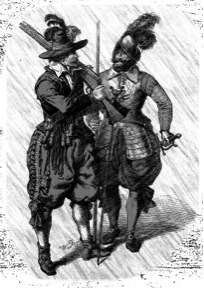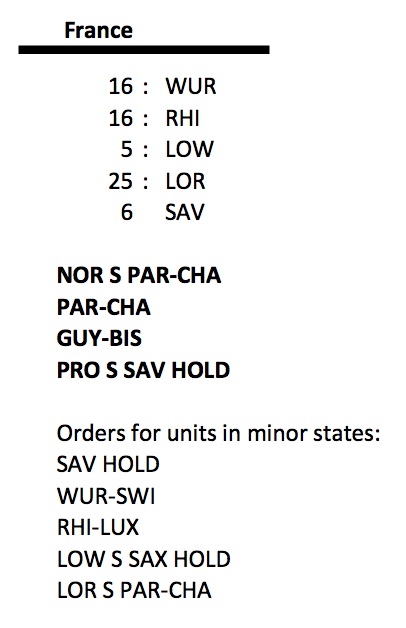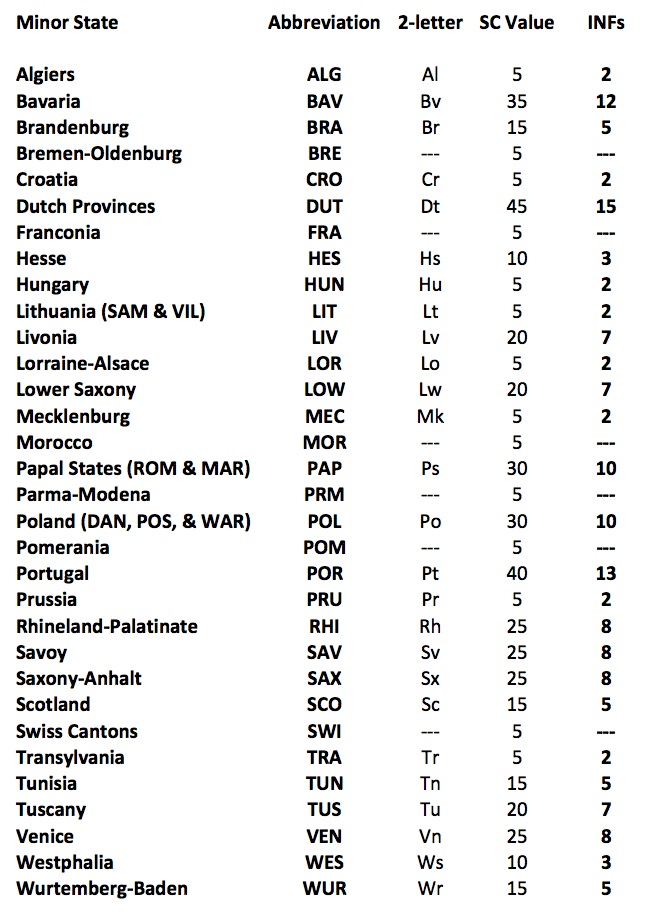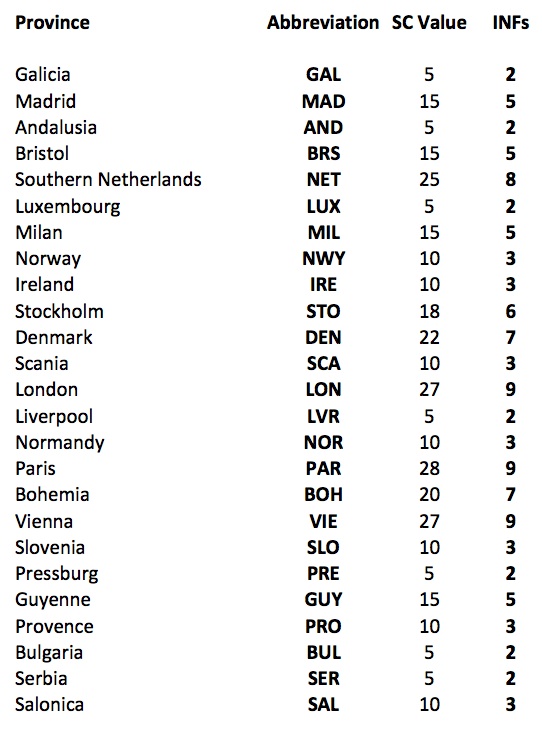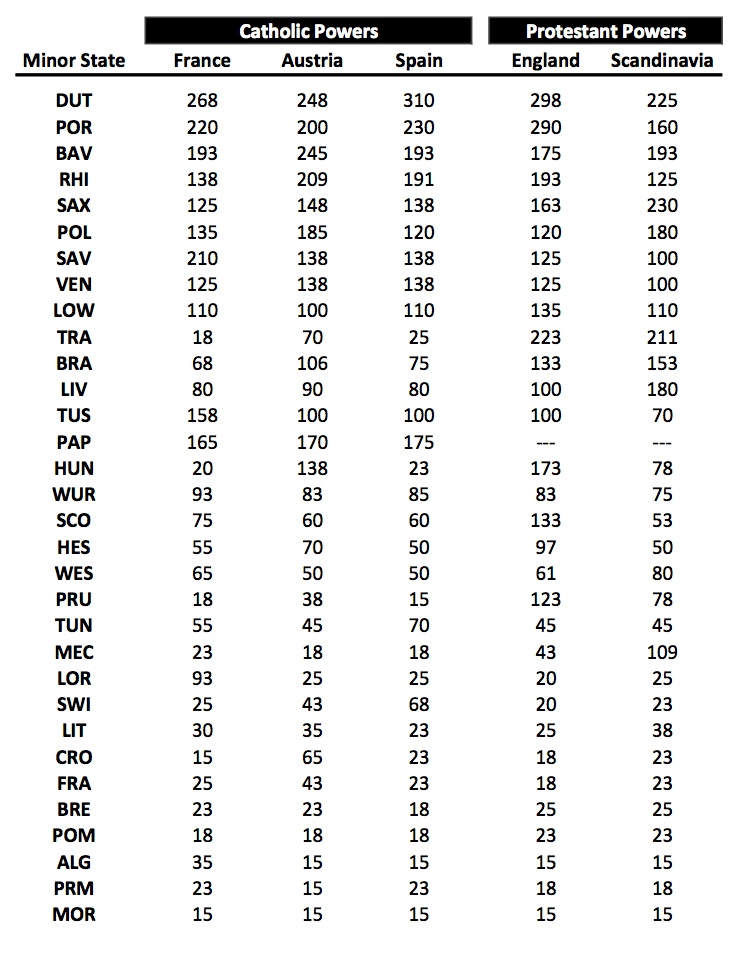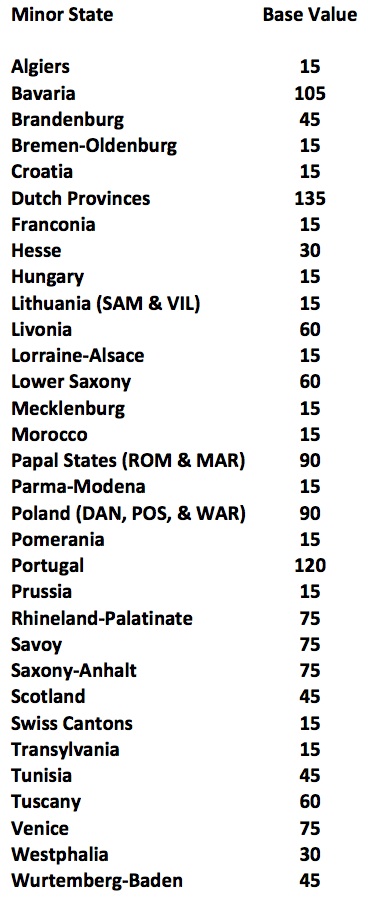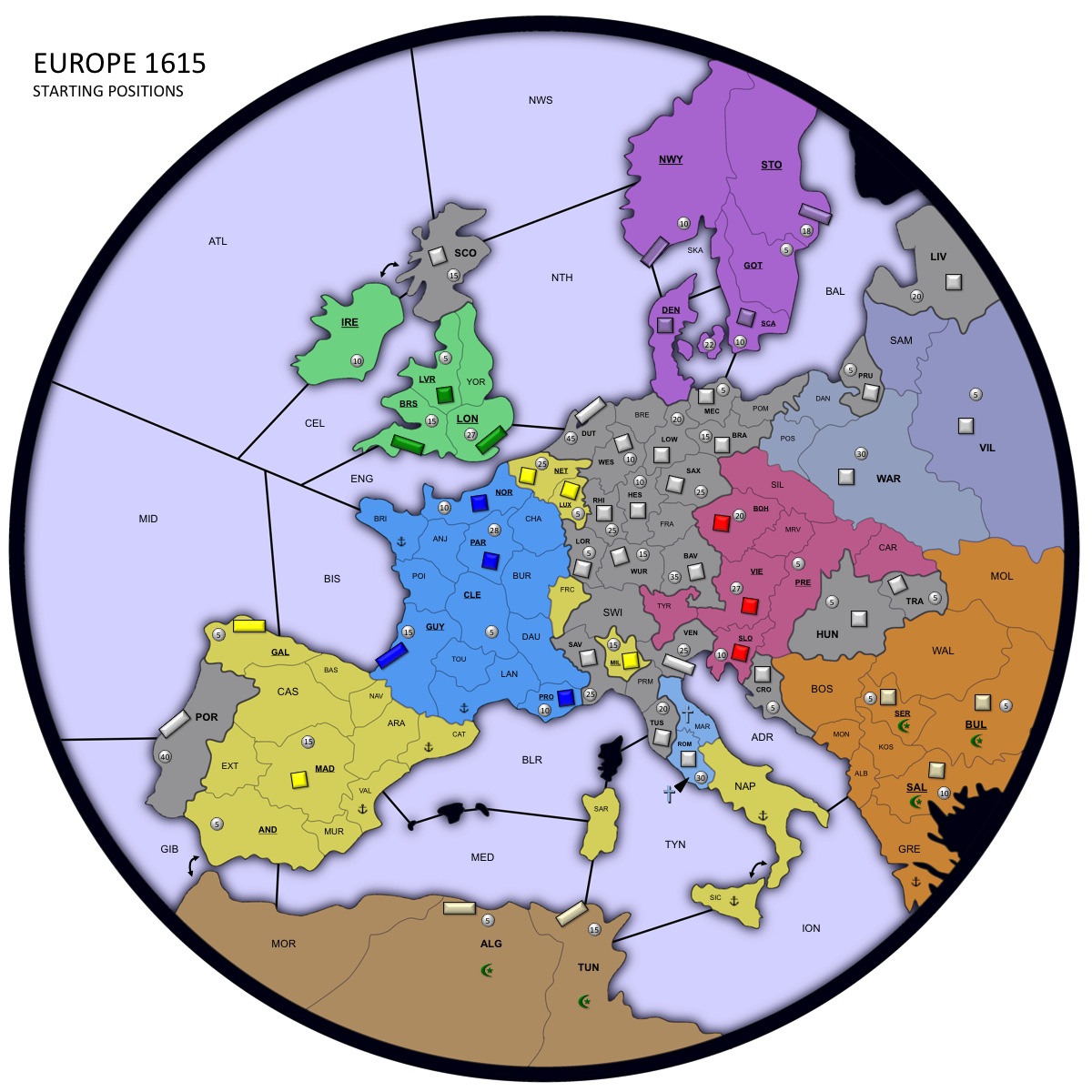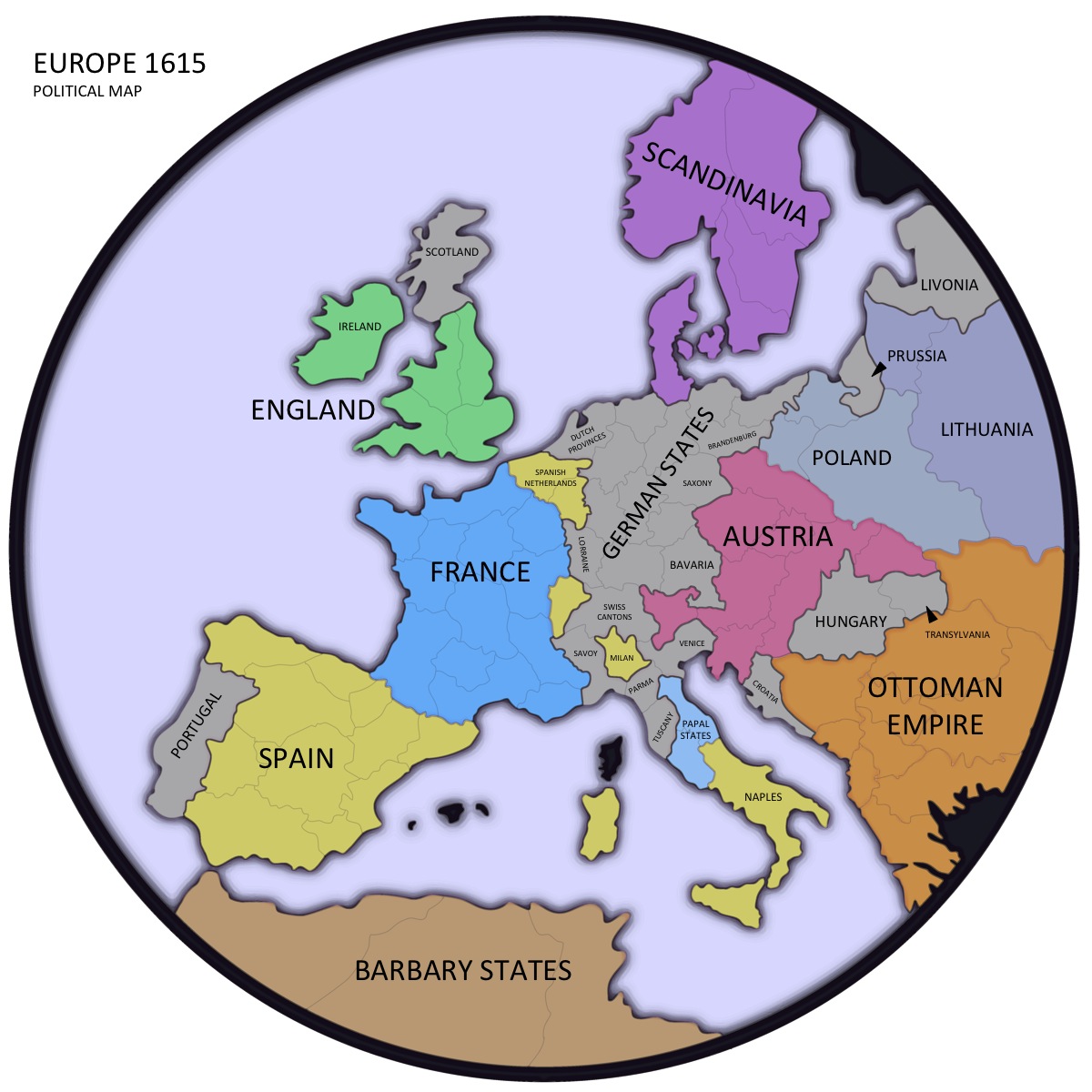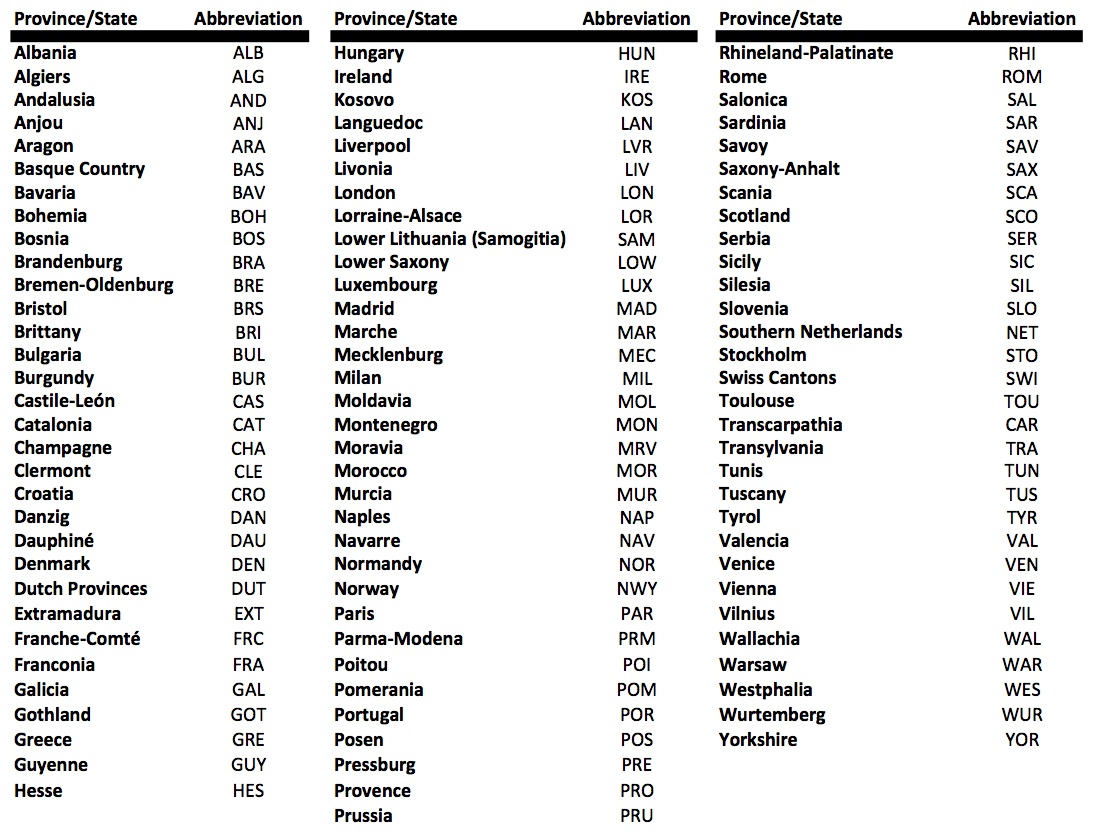Europe 1615: Prelude to War
EUROPE 1615: PRELUDE TO WAR
A DIPLOMACY VARIANT
by Matthew Medeiros
[Play-testers needed! Any comments or questions please write to medeiros412@aim.com, thank you.]
INTRODUCTION
The Europe 1615 Diplomacy variant allows players to take the reigns of one of the great powers of the time: Austria, France, Spain, England, and the Scandinavian Kingdoms (Denmark and Sweden). For the purposes of this game, Denmark and Sweden are treated as in a permanent alliance and controlled by one player. During the game, players deploy influence points (INFs) to secure political and/or religious control over minor states. The Ottoman Empire can be influenced as well, and may be controlled anonymously by one of the players. Victory is measured by the gain of victory points (VPs) through various aspects of the game (military and political objectives). Game begins in 1615 and runs up until the end of 1620. Each game year consists of 3 movement/retreat phases, and a build phase (and in some years, a scoring phase).
Standard 5th Edition rules of Diplomacy apply with modifications as described below.
PHASES OF THE GAME YEAR
1- Spring Movement and Retreat Phase
2- Summer Movement and Retreat Phase
3- Fall Movement and Retreat Phase
4- Winter Ownership/Build/Adjustment Phase
5- At the end of 1616, 1618, and 1620 there is an additional phase called the Scoring Phase.
DEPLOYMENT OF INFLUENCE POINTS WITH SUBMISSION OF ORDERS
Each power receives influence points (INFs) at the beginning of each phase to distribute to the minor states with orders.
INFs Available per Phase
Writing the orders: Example of the syntax for the submission of the INF deployment list and orders is as follows:
In the above example, France deploys INFs to Wurtemburg (WUR), Rhineland (RHI), Lower Saxony (LOW), Lorraine (LOR), and Savoy (SAV). In addition to submitting orders for French units (shown in bold) in Normandy (NOR), Paris (PAR), Guyenne (GUY), and Provence (PRO), France submits orders to the units in the minor states listed above as well.
A listing of the minor states that may be influenced is given below.
List of Pliant Minor States, SC Values, and INF values
Note: The Catholic powers, only, may deploy INFs to the Papal States (PAP) [consists of Rome (ROM) and the Marche (MAR)] with orders. Poland (POL) consists of the provinces of Warsaw (WAR), Danzig (DAN) and Posen (POS), therefore, their statuses will match POL. Lithuania (LIT) consists of Samogitia (SAM) and Vilnius (VIL). Two-letter designations for each minor state are given to label the armies/fleets on the board.
Influencing the Ottoman Empire and the Barbary States
The Ottoman Empire (OTE/Ot) is treated much like the pliant minor states, however, the Empire spans over several provinces and has 3 units in its military service: A(SAL), A(SER), and A(BUL). As a whole, INFs may be deployed to the Ottoman Empire with corresponding orders. The Barbary States consist of Morocco (MOR), Algiers (ALG/Al), and Tunis (TUN/Tn), and INFs can be deployed to each separately. The GM keeps the deployment of INFs to the Ottoman Empire secret, and only reveals its status.
Adjudication
Status of the minor states: The minor state is marked as ALIGNED, NEUTRAL or UNMARKED depending on how the major powers invest INFs in the minor state. Minor states marked as ALIGNED are in allegiance with the major power holding the most influence (50% or more of the total INFs deployed to the state) and will follow the orders submitted by the power. For two or more powers equally invested in a minor state, the minor state will be marked as NEUTRAL and the orders submitted to those states will be ignored.
Minimum # of INFs for an alignment:
Minor States & Barbary States = 5
Ottoman Empire = 15
The required percentage of INFs for gaining the alignment of the Ottoman Empire per year:
Explanation: The political status of the minor state is ALIGNED if a single major power holds 50% or more of the total INFs present in the minor state and has minimally 5 INFs invested. Orders submitted by the power to any aligned state will be followed and reported in the adjudication. The allegiance of the Ottoman Empire, in 1616, requires that a major power holds 80% or more of the total INFs present and minimally 15 INFs invested. The GM keeps the aligned major power for the Ottoman Empire secret. Political status of a minor state is not established if there are less than 5 INFs present. Minor state is then considered UNMARKED. (If there are less than 15 INFs in the Ottoman Empire, its status will default to NEUTRAL; this rule also applies to the Barbary States when there are less than 5 INFs present.) After submission of orders and INF deployment, the GM publishes the results, which powers have deployed to which states and whether the orders submitted are followed or not, but does not reveal the actual number of INFs deployed by each power; instead, the percentage of INFs held is published. INFs will continue to accumulate in the states with each deployment.
Rules Concerning Political Status of Minor States
(1) If the political status is not established (UNMARKED), any major power may move into and/or capture the minor state.
(2) If the political status is NEUTRAL, no major power can enter the minor state as it violates the neutrality status. Neutral units within neutral states cannot receive support.
(3) If the political status is ALIGNED, the major power that holds the majority of INFs in the minor state can submit HOLD, SUPPORT, MOVE/ATTACK, or CONVOY orders to the minor state's unit. Major power will also be responsible for ordering retreats for the unit (or new builds, as in the case of the Ottoman Empire). The major power cannot dislodge or support the dislodgment of the minor state's unit, even if that dislodgment is unexpected. Additionally, the major power may SUPPORT the unit's HOLD or MOVE (other powers may SUPPORT the unit as well). If no unit is present in an ALIGNED minor state, any major power may enter freely. For a power aligned with the Ottoman Empire, the power may submit orders to all units of the Empire, and the GM keeps the player anonymous, but orders are published in adjudication. Communications with the Ottoman Empire should be conducted by public white/grey press or through the GM.
Rules Concerning the Minor State and Its Army
Capturing an SC: The minor state's army cannot capture a supply center. It can prevent the gain of INFs by the owner. It can also prevent scoring should the army occupy a minor state that is aligned with another power. However, the units of the Ottoman Empire are able to capture supply centers and contribute to its expansion.
Disbanding: If the supply center of a minor state is captured when the state's army is position elsewhere on the board, the army is disbanded at the build phase.
Movement: A major power may move into its ALIGNED state if the army is not present, but cannot capture the supply center as long as it is aligned.
Concerning neutrality: If minor state changes to a neutral state, a major power's army situated in the minor state can still function to support, attack, hold, etc., however, if the army maintains its position into a build phase, it is then interned and disbanded. If the army moves out of the neutral state, no other army can enter, but while holding its position in the neutral state it is open to attack and dislodgment (neutral state harbors an active power's unit, so other powers have the right to attack). If the minor state becomes neutral after its army has moved, the state's army holds its position where ever it is on the board, and is disbanded if dislodged. Neutral army's position may be supported if it is not in its state of origin.
Capture of the minor state: If a major power captures a minor state's supply center, then the state is permanently withdrawn from the list of pliant minor states. It can no longer be influenced. The occupying power will earn VPs for the capture of the supply center and additional INFs as mentioned above, but forfeits any VPs that could be earned from the Objectives Tables at the scoring phase. If the minor state was marked as religiously controlled, it retains that status even after being captured; however, it loses any alignment status, and all INFs invested in the state are locked in as is. Religious control is still subject to the changing percentage threshold by year.
Note: All SCs of the Ottoman Empire must be captured for the state to be eliminated from the list.
Additional Rules
INF gains and losses: Powers also receive additional INFs from the capture of a supply center (see table of pliant minor states and INF values). This gain is maintained as long as the power captures (at the build phase) and maintains control of the minor state.
(1) If the captured supply center of a minor state is controlled by the opposition religion (Catholics versus Protestants), no gain in INFs is possible.
(2) If an owned supply center is occupied by a minor state's army that is aligned with another power, then INFs cannot be gained from that supply center. (Armies of neutral minor states will have no effect on the gain of INFs.)
(3) A power will lose INFs from the loss of a home supply center equal to the VALUE of the supply center.
List of Home Supply Centers, SC Values, and INF Values
SC Values: These values essentially rank the importance of a supply center (or province, where there is not a SC). INF value, victory points for the capture, and other rewards are calculated from the SC values.
Religious Status of the Minor States After the Influence Phase
The combined INFs remaining for England and Scandinavia represent the influence of the Protestant factions in the state. The combined INFs of Austria, France and Spain represent the influence of the Catholic factions in the state. Control of a province by either the Protestants or Catholics is determined by the following: The religious status of the minor state is CONTROLLED if a single religious faction holds 75% of the total INFs in the state, and has minimally 10 INFs invested. If the condition above is not met then the state is marked as religiously NEUTRAL. Religious control is marked on the map throughout the game and becomes important during the scoring phases, and the build phases. Papal States will always be marked as Catholic controlled. Religious status for the Ottoman Empire and the Barbary States do not change. They are, for the purposes of this game, permanent Islamic states.
SCORING PHASE
Earning Victory Points (VPs) Based on Alignment/Religious Status of the Minor States and the capture of SCs
Victory points are awarded at three periods in the game. Scoring depends on the capture of SCs (beyond home supply centers), and a reward system based on the alignment and religious status of the minor states. It is important to note that this rewards system only applies for minor states that have not been captured by a major power. It will be up to the players to weigh the benefits and drawbacks of capturing a minor state’s supply center.
TABLE 1: Objectives Table and VP Awards (Rewards for Alignment)
TABLE 2: Objectives Table and Awards for Alignment AND Religious Control of Minor States
TABLE 3: Victory Point Value for the Capture of a Minor State or Province
Explanation and Examples
Reviewing the tables above: If Saxony is aligned with Austria, then Austria can garner 148 VPs at the scoring phase (TABLE 1). If Saxony is aligned with Austria AND Catholic controlled, then Austria can garner 295 VPs at the scoring phase (TABLE 2). The only situation where Austria cannot garner points from the alignment and/or Catholic control is if Saxony is occupied by an army of another minor state (one that is not aligned with Austria).
If Scandinavia captures Saxony, Scandinavia can earn 75 VPs at the scoring phase (TABLE 3). Saxony is then withdrawn from the list of pliant minor states. No power (including Scandinavia) can garner points on the alignment or religious control of the state from that point in time onwards. If Saxony is Catholic controlled at the time when Scandinavia captures the supply center, then Scandinavia gains the 75 VPs at the scoring phase, and gains a new build, but is unable to garner the INFs from the capture. (This scenario can be thought of as a Catholic state under Protestant occupation; the state is in revolt and influence cannot be gained by the occupying power.)
Note: No points are garnered for NEUTRAL minor states.
Scoring Metric
Three cumulative scoring sessions are done: one at the end of 1616, another at the end of 1618, and the other at the end of the game. Therefore, it is possible for a power to score VPs on the alignment and/or religious control of a minor state 3 times (this also applies to the capture of supply centers). A player can still score, for example, on the religious control of a minor state in the first-half of the game, even after losing the control in the second-half, as the VPs gained at each scoring phase are permanent. Based on this system of scoring, players are ensured a score for his/her efforts in the game, regardless of the final outcome of the game (unless the player is eliminated: see below under ELIMINATION AND EFFECTS OF).
Scoring phases in the game:
Checklist: During the scoring phase, the following questions should be evaluated to determine the overall score of a power.
(1) Did the power acquire/capture any new supply centers?
(2) Are there any minor states aligned to the power?
(3) Are there any minor states aligned to the power and under religious control?
(4) Are there any minor states aligned to the power but occupied by an army of another minor state that is not aligned with the power?
BUILD/ADJUSTMENT PHASE
Waiving the capture of a supply center: The player occupying a major power's supply center, or a minor state's supply center, or a province at the build phase may waive the capture of the supply center or province. This may be arranged by the player (and communicated to the GM) to avoid depriving a center from an ally. Once the decision is made no reversal is allowed until the next build phase. Provinces or states held by a major power are absorbed into the power, unless it is an ALIGNED state to the power that occupies it.
Concerning supply centers: Each supply center controlled during the build phase provides the resources to field 1 army or 1 fleet (as in standard diplomacy). Players may build new units on any unoccupied home supply center or captured supply center of a minor state (as long as the minor state is not controlled by an opposing religion). Owned/controlled home ports may be used as a build site for fleets (anchor symbol on map). Builds are not allowed in captured home SCs of the Ottoman Empire or the Barbary States. Protestant powers cannot build in a captured Catholic power’s SC or port, and the same rule applies to Catholic powers with captured Protestant SCs or ports.
Re-building a minor state's army: If a supply center of a minor state is unoccupied and has yet to be captured by a major power, a new unit is built if the original unit was previously disbanded.
STARTING POSITION OF UNITS
France: A(PAR), A(NOR), A(GUY), F(PRO)
Spain: F(GAL), A(MAD), A(LUX), A(MIL), A(NET)
Austria: A(BOH), A(SLO), A(VIE)
England: A(BRI), F(LON), A(LVR)
Scandinavia: F(STO), A(DEN), A(SCA), F(NWY)
Starting Deficit: Each power starts with one unit less than the number of home supply centers.
Total Supply Centers: 24 home SCs + 26 minor state SCs + 3 Ottoman SCs = 53.
ELIMINATION AND EFFECTS OF
Any player who has been eliminated based on standard Diplomacy rules, cannot continue receiving nor deploying INFs for the remaining years, and all scores are ceded. INFs of the eliminated power that have been deployed to all minor states are removed and the statuses of the minor states reassessed at the next influence phase (this includes captured minor states, where the removal of INFs may impact the religious status; and includes the Ottoman Empire and Barbary States, where the alignment can change).
VICTORY CONDITIONS
At the end of 1620, the player with most VPs wins the game. If there is a tie in VPs between the two top-ranked players, then victory will depend on the player with the most supply centers; if there is a tie on SCs, then victory will depend the player with the most INFs.
Optional Alliances and Victory Conditions: Two players, before the start of 1618, may form an alliance. This is a permanent agreement and is communicated to the GM and declared to the other players. Alliances do not change the rules of the game, but affects victory condition. It is possible for two alliances to form in the game. At the end of the game, an alliance wins if the combined VPs of the two allies exceed the total VPs of the other three players (or the other alliance and the fifth player). Alliances are bound to this rule to the end, so it is possible that a single unallied player can (1) win the game with a minimum amount of VPs by bringing about a balance of power between two alliances; or (2) exceeding the other two unallied players in total VPs given the only alliance cannot meet the condition above.
REFERENCES/ACKNOWLEDGEMENTS
History, concepts, and rules adapted from:
Core Rules
Standard Diplomacy by Allan Calhamer (Rest in peace!)
Adapted Map Structure, Unit Positions, and Supply Centers
1600 by Tommy Larsson
1648 by Charles Feaux de le Croix
The Influence of Minor States
Ambition and Empire by B. M. Powell and Jeff Kase
Status of States and Their Treatment; Victory Points and Time Limit
Formal Diplomacy by E. Sabatine and Edi Birsan
How to Handle the Ottomans Empire
Juggernaut Diplomacy by Tim Snyder and Jamie Drier
Influence, Diplomatic Attacks, and Scoring System
Origins of World War 1 by Jim Dunnigan
Origins of World War 2 by Jim Dunnigan and Thomas Shaw
First Session Play-testers
Mark Utterback, Max Victory, Steven Caponigri, Aaron Havas, and Greg Bim-Merle.
Political and Military History
The Thirty Years War by C.V. Wedgwood
Wikipedia entry:- http://en.wikipedia.org/wiki/Thirty_Years'_War.
Britannica entry:- http://www.britannica.com/EBchecked/topic/592619/Thirty-Years-War.
Europe 1615 Map and Starting Positions
